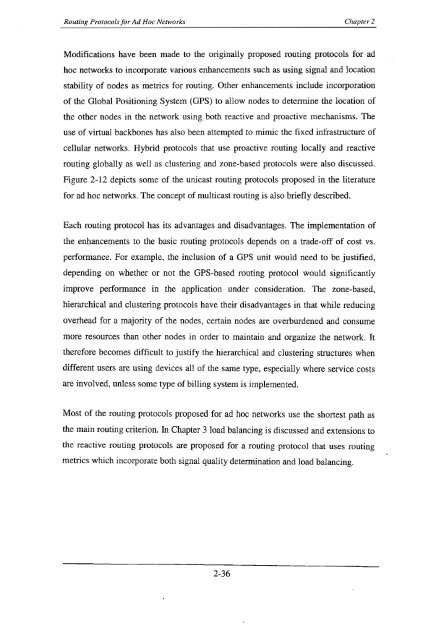Gugrajah_Yuvaan_ Ramesh_2003.pdf
Gugrajah_Yuvaan_ Ramesh_2003.pdf
Gugrajah_Yuvaan_ Ramesh_2003.pdf
You also want an ePaper? Increase the reach of your titles
YUMPU automatically turns print PDFs into web optimized ePapers that Google loves.
Routing Protocolsfor Ad Hoc Networks Chapter 2<br />
Modifications have been made to the originally proposed routing protocols for ad<br />
hoc networks to incorporate various enhancements such as using signal and location<br />
stability of nodes as metrics for routing. Other enhancements include incorporation<br />
of the Global Positioning System (GPS) to allow nodes to determine the location of<br />
the other nodes in the network using both reactive and proactive mechanisms. The<br />
use of virtual backbones has also been attempted to mimic the fixed infrastructure of<br />
cellular networks. Hybrid protocols that use proactive routing locally and reactive<br />
routing globally as well as clustering and zone-based protocols were also discussed.<br />
Figure 2-12 depicts some of the unicast routing protocols proposed in the literature<br />
for ad hoc networks. The concept of multicast routing is also briefly described.<br />
Each routing protocol has its advantages and disadvantages. The implementation of<br />
the enhancements to the basic routing protocols depends on a trade-off of cost vs.<br />
performance. For example, the inclusion of a GPS unit would need to be justified,<br />
depending on whether or not the GPS-based routing protocol would significantly<br />
improve performance in the application under consideration. The zone-based,<br />
hierarchical and clustering protocols have their'disadvantages in that while reducing<br />
overhead for a majority of the nodes, certain nodes are overburdened and consume<br />
more resources than other nodes in order to maintain and organize the network. It<br />
therefore becomes difficult to justify the hierarchical and clustering structures when<br />
different users are using devices all of the same type, especially where service costs<br />
are involved, unless some type ofbilling system is implemented.<br />
Most of the routing protocols proposed for ad hoc networks use the shortest path as<br />
the main routing criterion. In Chapter 3 load balancing is discussed and extensions to<br />
the reactive routing protocols are proposed for a routing protocol that uses routing<br />
metrics which incorporate both signal quality determination and load balancing.<br />
2-36
















